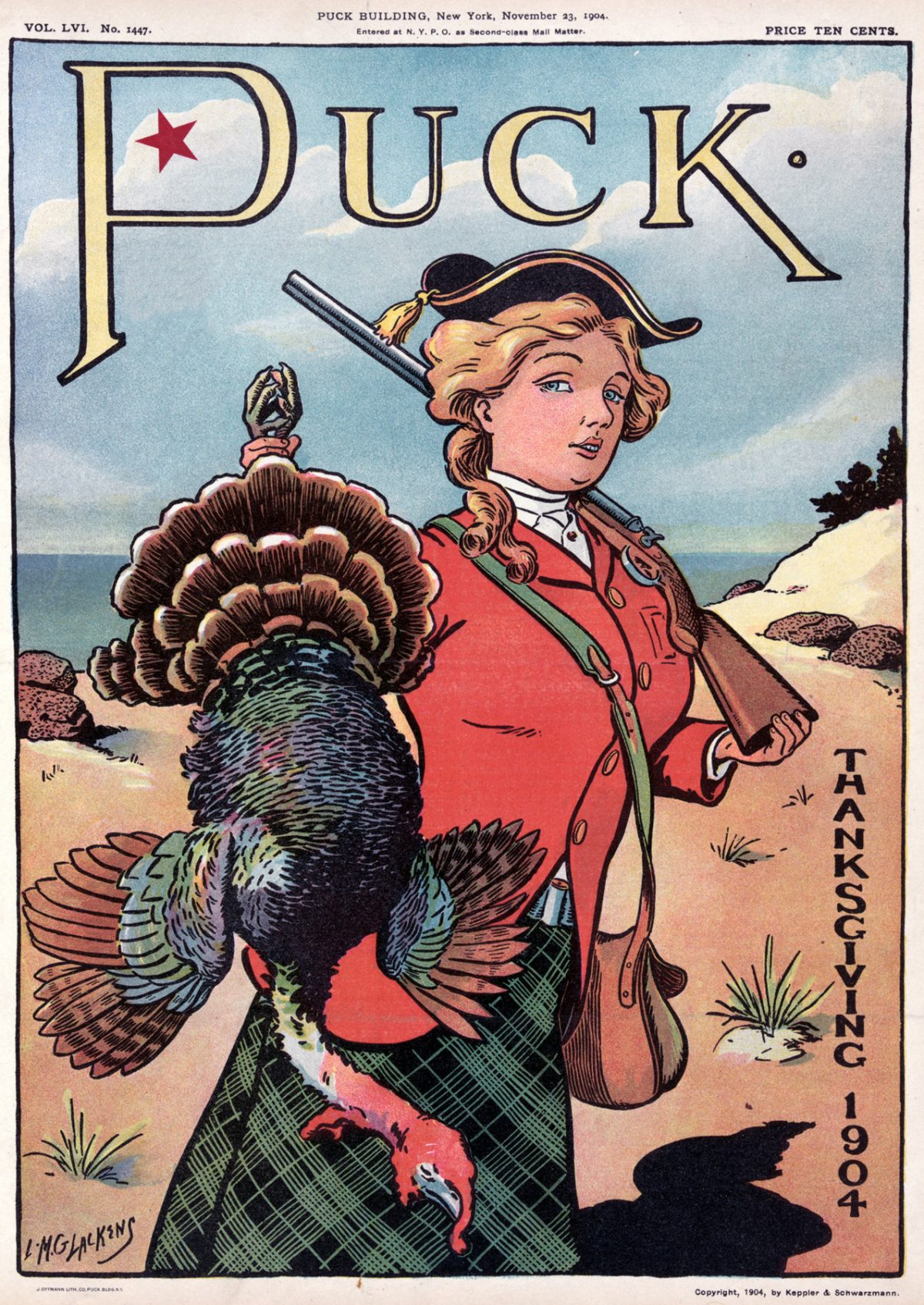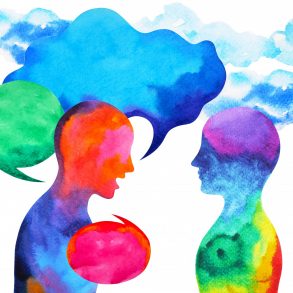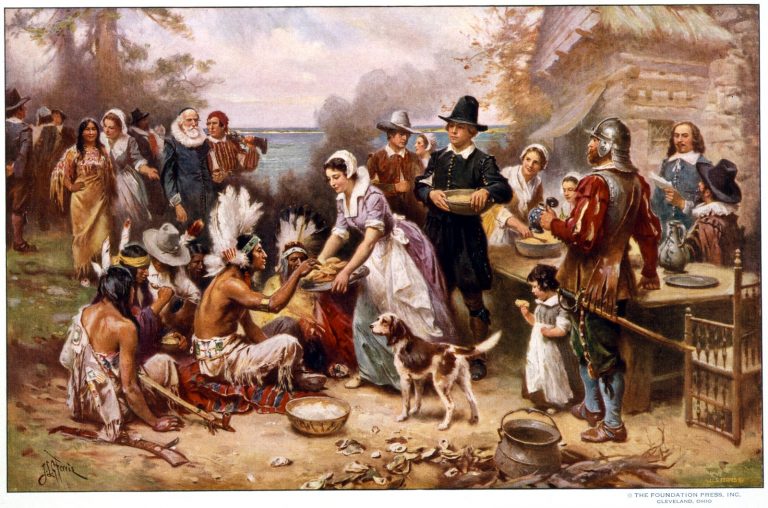How much do you think you know about the history of the most American of holidays — Thanksgiving? Test your smarts here!
1) In the spring of 1610, in what many consider the “first American Thanksgiving,” colonists in Jamestown, Virginia, held a thanksgiving prayer service after English supply ships arrived with much-needed food.
2) The Pilgrims at Plymouth Colony celebrated the autumn harvest in October 1621 with a three-day feast. Governor William Bradford invited the chief of the Wampanoag tribe, Massasoit, to join the fifty colonists who had survived the harsh winter. The Native American leader brought ninety of his tribesmen to the feast.
3) The First Thanksgiving celebration included athletic contests, a military review led by Myles Standish, and a feast on foods such as wild turkeys, duck, geese, venison, lobsters, clams, bass, corn, green vegetables and dried fruits.
4) The name “cranberry” derives from the Pilgrim name for the fruit, “craneberry” — so named because the small, pink blossoms that appear in the spring were thought to have resembled the head and bill of a Sandhill crane.
5) The word “pumpkin” originated from the Greek word “pepon,” which means “large melon.” The word “pepon” was pronounced in different languages several ways before the American colonists started calling it “pumpkin.”
6) Early Americans would slice off the top of a pumpkin, remove the seeds, fill the insides with milk, spices and syrup, and bake it for hours in hot ashes — the first version of pumpkin pie.
7) On October 3, 1789, the first President of the United States, George Washington, proclaimed November 26th to be a day of national thanksgiving and prayer after receiving Congressional requests for such a decree.
8) The American Intercollegiate Football Association held its first championship game on Thanksgiving Day, 1876. By the 1890s, perennial favorites Yale and Princeton drew huge crowds of fans for the collegiate championship games, and thousands more club, college, and high school football games were played on the holiday.
MORE: The history of Thanksgiving Day football
9) In 1921, the community of Plymouth, Massachusetts erected a statue memorializing the Wampanoag Indian leader, Massassoit, 300 years after he and ninety of his tribesman joined the Puritans at Plymouth Colony for a three-day feast of thanksgiving. The inscription on the statue reads in part, “Massasoit, great Sachem of the Wampanoags, Protector and Preserver of the Pilgrims, 1621.”
10) 26,000 fans watched the Detroit Lions face the Chicago Bears at the University of Detroit Stadium in the first National Football League game held on Thanksgiving Day of 1934. Ninety-four stations on the NBC radio network broadcast that game, and televised broadcasts of games began in 1956.
11) In 1939, President Franklin Delano Roosevelt declared November 23rd, the next-to-last Thursday of the month, to be Thanksgiving Day. This break with tradition was prompted by requests from the National Retail Dry Goods Association to extend the Christmas shopping season by one week. Roosevelt had rejected the association’s similar request in 1933 on the grounds that such change might cause confusion.
12) In 1941, after two years of confusion and complaint, President Franklin D Roosevelt signed legislation establishing Thanksgiving Day as the fourth Thursday in November.
13) On Thanksgiving Eve 1947, President Harry Truman “pardoned” a turkey the day before it was scheduled to be a main attraction at the White House Thanksgiving dinner. The pardoning of one lucky bird, along with the commutation of a trip to the chopping block into a lifelong stay in a Virginia petting zoo, is now an annual Thanksgiving event at the White House.
14) The US isn’t the only country to celebrate a Thanksgiving holiday! It’s also observed in Canada, Grenada, Liberia, The Netherlands and Norfolk Island (an Australian territory). Germany has similar harvest festivals, and Japan has a national holiday in November called Labor Thanksgiving Day.

What is the origin of the first Thanksgiving?
In the fall of 1620, a group of 102 men, women and children — now referred to as the Pilgrims — left Plymouth, England aboard the Mayflower and set sail for the New World to find religious freedom.
After 66 days at sea, they finally landed at what is now Plymouth, Massachusetts. They had a rough first winter living aboard the ship as they had no other shelter — they lost half their passengers to the elements, as well as to scurvy and other contagious diseases.
In spring of 1621, the Pilgrims were able to move ashore to start establishing a settlement. Soon after moving to land, they were surprisingly greeted in English by two Indians, one a member of the Abenaki tribe and Squanto, a member of the Pawtuxet tribe. Squanto had been previously taken into slavery to England, where he learned the language, but was able to escape and make his way back to America.
MORE: Dinner and a movie: ‘A Charlie Brown Thanksgiving’
Squanto played a pivotal role in the Pilgrim’s survival. He taught them how to grow corn, extract sap from maple trees, fish in nearby rivers and streams, and pick safe plants to eat. Squanto also helped the Pilgrims nurture a relationship with the Wampanoag tribe—an alliance that lasted more than 50 years.
By the fall of 1621, the Pilgrims, or Plymouth colonists, and the Wampanoag Indians were celebrating their fruitful harvest. They shared a three-day feast, offering thanks for the successful growing season—a festival that is now remembered as the “first Thanksgiving.”
A feast of thanksgiving was celebrated off and on for two centuries until finally in 1863, during the Civil War, President Abraham Lincoln proclaimed Thanksgiving Day a federal holiday on the last Thursday of November (find out how it ended up on the fourth Thursday of November here.)
Check out other holiday history related articles:
- The history of New Year’s Day is as rich as the food you will eat while you celebrate
- Valentine’s Day has a rich history you probably have never learned about
- Passover history and fun facts to know
- Watch kids explain the history of Easter & try not to LOL
- Mother’s Day history: A timeline
- The history of Halloween: A timeline through the centuries
- What is the history of Christmas that has been shared for centuries through generations of Christians?
Excerpted from materials by the US Library of Congress & The NC Department of Agriculture and Consumer Services









